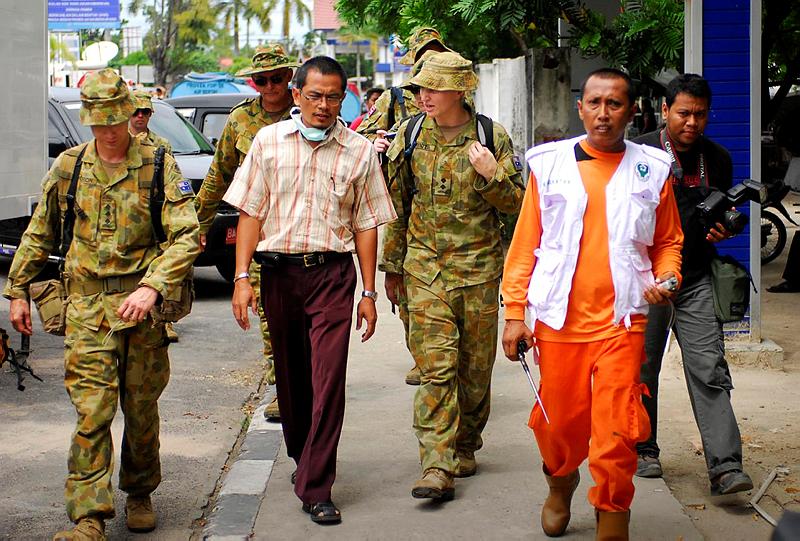 In the 2009 Defence White Paper, the Government expected the ADF to carry out a number of tasks. In addition to its core war fighting roles, there were a number of secondary tasks, including missions that involve an overlap of responsibility with other government agencies. In this category were a range of activities; protecting our offshore estate; contributing intelligence, surveillance, and reconnaissance capabilities for border protection; assisting civil authorities protect major events and deal with counterproliferation; supporting emergency response efforts for natural disasters within Australia and our neighbourhood; and providing marine search and rescue.
In the 2009 Defence White Paper, the Government expected the ADF to carry out a number of tasks. In addition to its core war fighting roles, there were a number of secondary tasks, including missions that involve an overlap of responsibility with other government agencies. In this category were a range of activities; protecting our offshore estate; contributing intelligence, surveillance, and reconnaissance capabilities for border protection; assisting civil authorities protect major events and deal with counterproliferation; supporting emergency response efforts for natural disasters within Australia and our neighbourhood; and providing marine search and rescue.
The rationale was that the ADF possesses a range of specialised capabilities on a scale and of a kind available from no other Australian agency and that humanitarian assistance and disaster relief operations need to be closely integrated with efforts by civilian agencies.
Sometimes the ADF would be expected to be the lead agency—in circumstances where there might be a need to demonstrate a willingness and capacity to employ military force, or where its substantial level of capacity is required in circumstances that are beyond that of other agencies. In other cases, the ADF will take a more secondary role. The evacuation of Australian nationals from foreign trouble spots might be one such case.
But according to the White Paper, these tasks don’t create a requirement for maintaining an extensive range of specialised capabilities within the ADF (are not ‘force structure determinants’). Rather, the expectation is that the ADF’s equipment and expertise needed for war fighting will generate a wide range of capabilities which can be deployed for such tasks. The argument in a nutshell is that war-fighting capabilities are the core business of the ADF, and Defence should contribute to other national missions only from capabilities acquired for its core business.
Next year’s Defence White Paper should test this proposition carefully to test whether we now need a more integrated whole of government approach to peacetime national security. It should also consider what priority Defence should afford to national missions where there’s an overlap of responsibility with other government agencies.
In the area of natural disaster response, for example, the 2013 White Paper might consider elevating domestic disaster assistance into a core Defence activity to ensure that this priority flows through the Defence organisation. As I’ve argued in the past, the ADF has become a valuable tool of the Australian government following a natural disaster to signal its humanitarian concerns or foreign policy objectives to both international and domestic audiences.
Elevating disaster assistance to an ADF core mission will generate costs, benefits and risks. Costs may include disruption to training schedules as personnel get deployed to response efforts and increased maintenance costs.
The benefits it will bring include providing personnel operational activities post-Afghanistan as well as exposure to working in a multi-agency environment.
The risks of not being involved in disaster response include damage to the ADF’s reputation if it fails to meet community expectations, as occurred when Navy couldn’t provide an amphibious ship for last year’s cyclone season.
Of course, that approach won’t be resource neutral. But being better able to respond to disasters won’t require the ADF to bring major disaster‑specific capabilities into existence; rather it will give greater emphasis to dual-use capabilities and might require some additional elements being maintained to provide better coverage.
Many of the capabilities that would be required to respond to domestic disasters would be useful to the ADF in undertaking some of its other tasks, such as humanitarian and disaster relief around the region. So including domestic disaster response as a force structure determinant could produce more depth for the ADF.
The 2013 White Paper should take a hard look at the specialised capabilities required in the ADF that are of a kind and scale available from no other Australian agency, and examine whether Defence is doing enough to build civil–military coordination capacity and inter-agency linkages.
Anthony Bergin is deputy director of ASPI. Image courtesy of Department of Defence.